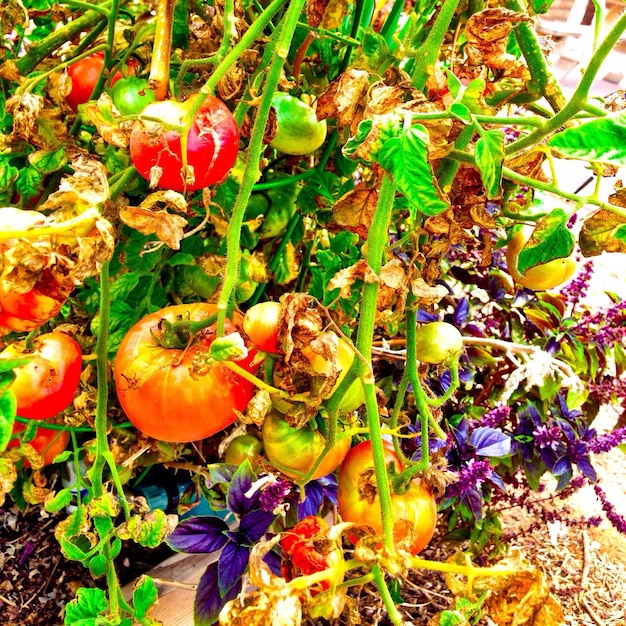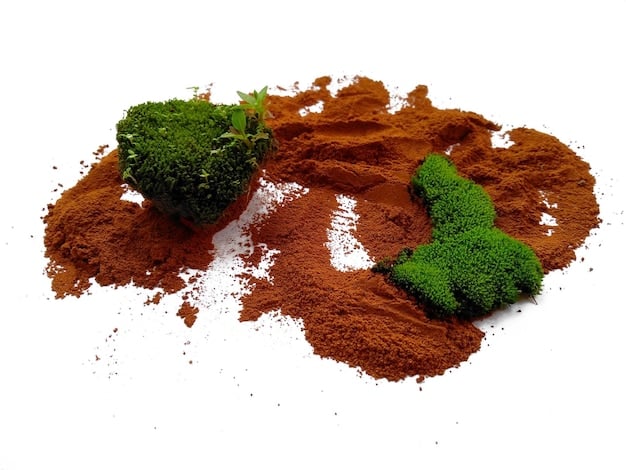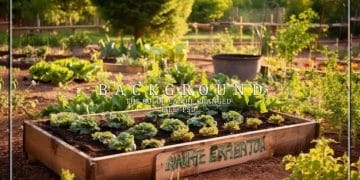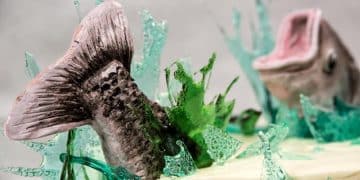Sustainable Living: Composting Guide – Turn Food Waste into Soil

Composting food waste is a sustainable practice that transforms kitchen scraps into nutrient-rich soil for gardening and reduces landfill waste, making your sustainable living journey more impactful.
Embark on a journey to transform your kitchen waste into garden gold with our comprehensive Sustainable Living: Composting Guide: Turn Food Waste into Nutrient-Rich Soil in Just 3 Months. Discover how easy it is to create a valuable resource that benefits your plants and the planet.
Why Compost? The Benefits of Sustainable Living
Composting is more than just a trendy buzzword; it’s a cornerstone of sustainable living. By diverting your food scraps and yard waste from landfills, you’re not only reducing methane emissions, a potent greenhouse gas, but also creating a valuable soil amendment for your garden.
Let’s explore the myriad benefits:
Reduces Landfill Waste
A significant portion of what we throw away is organic material that could be composted. By composting, you actively decrease the strain on landfills, extending their lifespan and minimizing environmental pollution.
Enriches Soil
Compost acts as a natural fertilizer, packed with essential nutrients that plants thrive on. It improves soil structure, water retention, and aeration, leading to healthier, more productive gardens.
Lowers Carbon Footprint
Decomposing organic waste in landfills produces methane. Composting, when done correctly, significantly reduces methane emissions, contributing to a smaller carbon footprint.

Reduces Need for Chemical Fertilizers
With nutrient-rich compost at your disposal, you can significantly reduce or even eliminate the need for synthetic fertilizers, which can harm the environment and disrupt soil ecosystems.
Composting is a win-win situation: you reduce waste, improve your garden, and contribute to a more sustainable future.
Getting Started: Choosing the Right Composting Method
The first step in your composting adventure is deciding which method suits your lifestyle and space. From low-maintenance outdoor piles to convenient indoor systems, there’s a composting solution for everyone.
Here are a few popular options:
- Backyard Composting: A traditional method involving building a compost pile or using a compost bin in your backyard. Ideal for those with ample outdoor space.
- Vermicomposting: Using worms to break down organic matter. Perfect for indoor composting, especially for apartment dwellers.
- Bokashi Composting: An anaerobic fermentation process that pickles food waste. Suitable for all types of food scraps, including meat and dairy.
Backyard Composting Basics
Backyard composting typically involves layering “greens” (nitrogen-rich materials) and “browns” (carbon-rich materials) in a pile or bin. Regular turning and watering are essential to maintain the right moisture and aeration for decomposition.
Vermicomposting: Worm Power
Vermicomposting is a closed-loop system where worms consume food scraps and produce nutrient-rich castings (worm poop). It’s a great option for those with limited space, as it can be done indoors with a worm bin.
No matter which method you choose, remember that the key to successful composting is maintaining the right balance of ingredients, moisture, and aeration.
Composting Ingredients: What to Include and Avoid
Understanding what to compost and what to avoid is crucial for creating healthy, odor-free compost. While most organic materials are compostable, some items can hinder the process or attract pests.
Here’s a breakdown:
- Greens: Nitrogen-rich materials like vegetable scraps, fruit peels, coffee grounds, and grass clippings.
- Browns: Carbon-rich materials like dried leaves, shredded paper, cardboard, and wood chips.
Materials to Include
shredded newspaper
Materials to Avoid
Certain materials can be problematic in a compost pile. Meats, dairy, and oily foods can attract pests and create unpleasant odors. Diseased plants can spread pathogens, and some weeds may survive the composting process.
By being mindful of what you add to your compost, you can ensure a healthy, productive decomposition process.

The Composting Process: From Waste to Wonderful
The composting process is a natural cycle where microorganisms break down organic matter into humus, a stable, nutrient-rich substance that benefits plants. This process requires the right balance of ingredients, moisture, and aeration.
Here’s a closer look at the process:
Layering Greens and Browns
The ideal ratio of greens to browns is approximately 1:2 or 1:3. Layering these materials creates a balanced environment for decomposition. Start with a layer of browns at the bottom of your compost bin or pile.
Maintaining Moisture
Your compost pile should be consistently moist, like a wrung-out sponge. Too dry, and the microorganisms won’t thrive; too wet, and the pile will become anaerobic and smelly. Water the pile regularly, especially during dry spells.
Turning and Aeration
Turning the compost pile regularly introduces oxygen, which is essential for the microorganisms to break down organic matter. Turn the pile every few days or weekly, depending on the size and activity level.
Observe your compost closely, and you’ll learn to recognize the signs of a healthy, thriving decomposition process. The pile should be warm, slightly damp, and have a pleasant earthy smell.
Troubleshooting Common Composting Problems
Composting can sometimes present challenges, but with a little troubleshooting, you can overcome common issues and achieve composting success. Let’s address some frequent problems:
Don’t worry, here are some of the common issues and how to avoid them:
Smelly Compost
A foul odor usually indicates that the compost pile is anaerobic, lacking oxygen. Turn the pile more frequently to introduce oxygen. Avoid adding meat, dairy, or oily foods, as these can contribute to unpleasant smells.
Slow Decomposition
Slow decomposition can be caused by several factors, including a lack of moisture, too many browns, or cold temperatures. Add water to moisten the pile, incorporate more greens, and wait for warmer weather.
Pest Problems
Fruit flies and other pests can be attracted to compost piles, especially those containing fruit scraps. Bury food scraps deep within the pile, cover the pile with a layer of browns, and consider using a compost bin with a secure lid.
Keep a close eye on your compost and adjust your practices as needed.
Using Your Compost: Nourishing Your Garden
After a few months of patient decomposition, your compost is ready to work its magic in your garden. This nutrient-rich soil amendment can transform your plants, boosting growth and vitality.
Here are some ways to incorporate compost into your garden:
- Soil Amendment: Mix compost into garden beds before planting to improve soil structure, water retention, and nutrient content.
- Mulch: Mulch around plants with compost to suppress weeds, conserve moisture, and slowly release nutrients into the soil.
- Potting Mix: Add compost to potting mixes to create a fertile growing medium for container plants.
Compost Tea
Compost tea is a liquid fertilizer made by steeping compost in water. It’s a great way to provide plants with a quick boost of nutrients and beneficial microorganisms. Use it as a foliar spray or a soil drench.
Spreading the Compost
When spreading compost in your garden, aim for a layer that is 1-3 inches thick. Gently incorporate the compost into the soil, avoiding damage to plant roots. Water the area thoroughly after applying compost.
With regular applications of compost, your garden will flourish, producing abundant harvests and vibrant blooms.
| Key Point | Brief Description |
|---|---|
| 🌱 Benefits of Composting | Reduces waste, enriches soil, and lowers carbon footprint. |
| 🪱 Composting Methods | Backyard, vermicomposting, Bokashi – choose based on space and needs. |
| 🍎 Ingredients | Use “greens” (nitrogen) and “browns” (carbon) in the right ratio. |
| 🐛 Troubleshooting | Address smells, slow decomposition, and pests with simple fixes. |
FAQ
▼
Composting time varies, but typically takes 3-6 months. Factors like temperature, moisture, and turning frequency affect speed.
▼
It’s generally best to avoid composting meat and dairy in backyard systems due to odor and pest attraction. Bokashi is a good alternative.
▼
An ideal ratio is about 1:2 or 1:3 of greens to browns. This balance provides the necessary carbon and nitrogen for decomposition.
▼
Ready compost is dark, crumbly, and has an earthy smell. It should be difficult to identify the original materials.
▼
A pile that’s not heating up may lack moisture, nitrogen, or oxygen. Add water, greens, and turn the pile to activate microbial activity.
Conclusion
Composting is a rewarding practice that contributes to a more sustainable lifestyle. By transforming your food waste into a valuable resource, you can enrich your garden, reduce landfill waste, and lessen your environmental impact.





